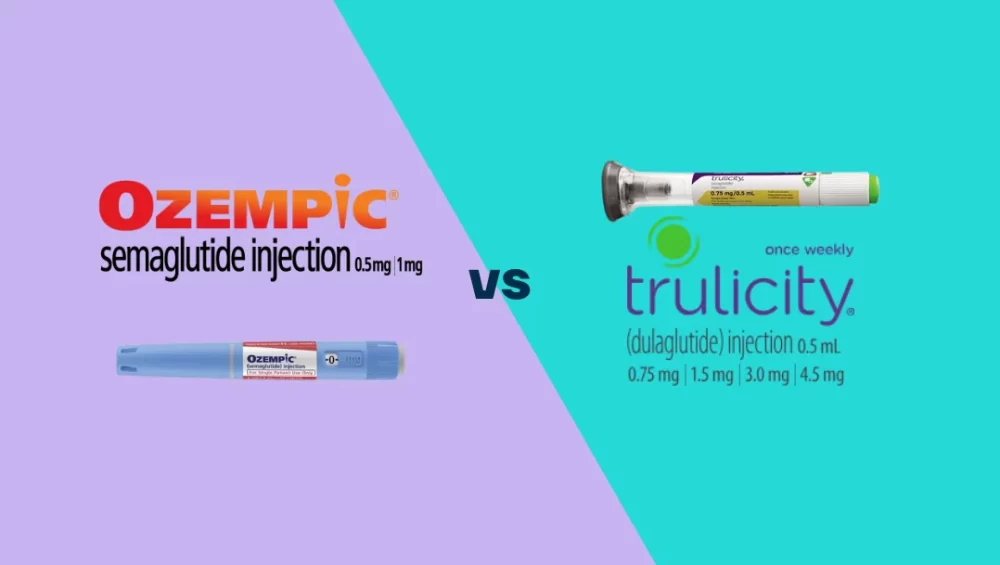When managing type 2 diabetes, choosing the right medication can significantly impact your health and quality of life. Two of the most popular options prescribed today are Ozempic (semaglutide) and Trulicity (dulaglutide)—both once-weekly injectable medications in the GLP-1 receptor agonist class. They help control blood sugar levels, support weight loss, and reduce cardiovascular risks. But how do they compare? In this article, we’ll break down the key differences and similarities to help you decide which might be right for you.
What Are Ozempic and Trulicity?
Both products are GLP-1 receptor agonists, which mimic a hormone called glucagon-like peptide-1. This hormone helps regulate blood sugar by stimulating insulin release, reducing glucagon (a hormone that raises blood sugar), and slowing digestion.
-
Ozempic is the brand name for semaglutide, made by Novo Nordisk.
-
Trulicity contains dulaglutide and is manufactured by Eli Lilly.
Both medications are approved by the FDA for adults with type 2 diabetes and are injected once weekly using a prefilled pen.
Efficacy: Which Works Better for Blood Sugar Control?
Clinical trials have shown that both are effective at lowering HbA1c (a key marker of blood sugar control). However, head-to-head studies, like the SUSTAIN 7 trial, found that Ozempic tends to result in slightly greater reductions in A1C and more significant weight loss compared to Trulicity.
-
Ozempic 1 mg lowered A1C by up to 1.8%.
-
Trulicity 1.5 mg lowered A1C by up to 1.4%.
If blood sugar control and weight loss are your top priorities, Ozempic may have the edge.
Weight Loss Benefits
While both medications promote weight loss, Ozempic has consistently shown greater weight reduction in clinical trials. Many patients choose Ozempic for this reason, especially if weight loss is an important part of their treatment plan.
-
Ozempic users lost up to 12 lbs or more.
-
Trulicity users lost approximately 6–10 lbs depending on the dose.
That said, individual results vary, and both medications have been beneficial in weight management for people with type 2 diabetes.
Dosage Options and Administration
Both come in weekly prefilled pens, but their dose ranges differ:
-
Ozempic: 0.25 mg (starter), 0.5 mg, 1 mg, and 2 mg
-
Trulicity: 0.75 mg, 1.5 mg, 3 mg, and 4.5 mg
Each pen is designed for once-weekly use, and both brands offer simple, user-friendly pens with hidden needles, ideal for patients new to injections.
Side Effects: What to Expect
The side effects of Ozempic and Trulicity are quite similar. Most are mild to moderate gastrointestinal symptoms, especially during dose escalation.
Common side effects include:
-
Nausea
-
Diarrhea
-
Vomiting
-
Constipation
-
Fatigue
These symptoms usually subside after a few weeks. However, serious risks, like pancreatitis, thyroid tumors, and gallbladder problems, are rare but possible for both drugs.
Cost and Insurance Coverage
Both medications can be expensive without insurance, often costing $800 or more per month. However, most insurance plans, Medicare, and discount cards (from Novo Nordisk or Eli Lilly) help reduce the out-of-pocket expense.
If affordability is a concern, speak with your healthcare provider or pharmacist about savings programs and generic alternatives.
Who Should Consider which one?
Ozempic may be better for you if:
-
You need stronger A1C reduction
-
You’re also targeting weight loss
-
You prefer smaller starting doses
Trulicity may be right if:
-
You prefer an auto-injector pen with a hidden needle
-
You’re sensitive to semaglutide’s side effects
-
You’re comfortable with your current results and want a trusted brand
Ultimately, both are excellent choices backed by clinical research. The best option for you depends on your health goals, medication tolerance, and insurance coverage.
Talk to Your Doctor
Before making a switch or starting a new GLP-1 medication, consult your healthcare provider. They’ll consider your medical history, current medications, lifestyle, and treatment goals to determine the best fit.
Final Thoughts
Both are powerful tools in managing type 2 diabetes. While Ozempic may offer a slight edge in glucose control and weight loss, Trulicity remains a reliable, well-tolerated option. Choosing the right medication is a personal decision—and with the guidance of your doctor, you can find a treatment that fits your needs.






